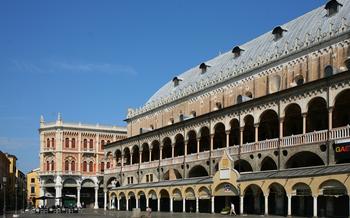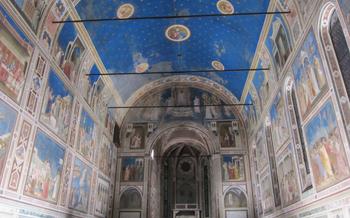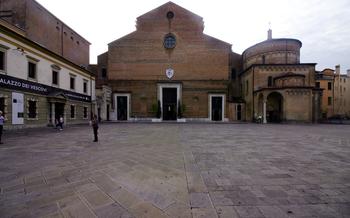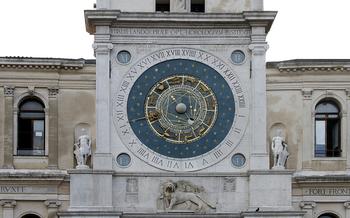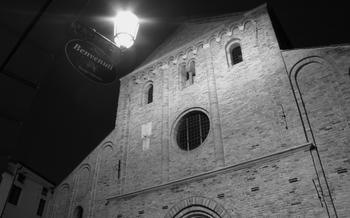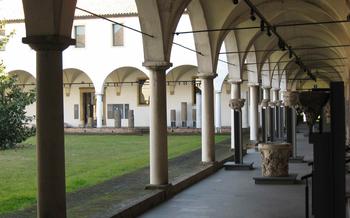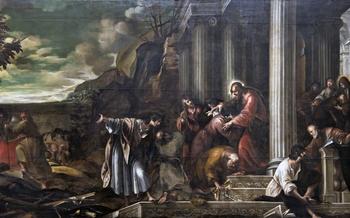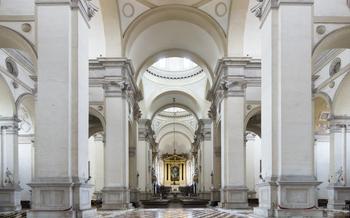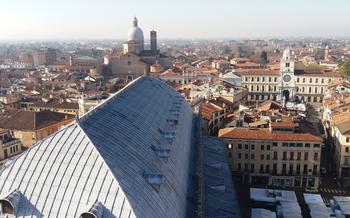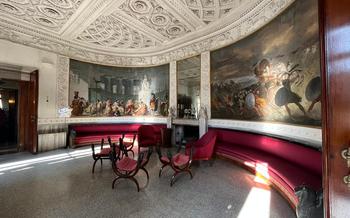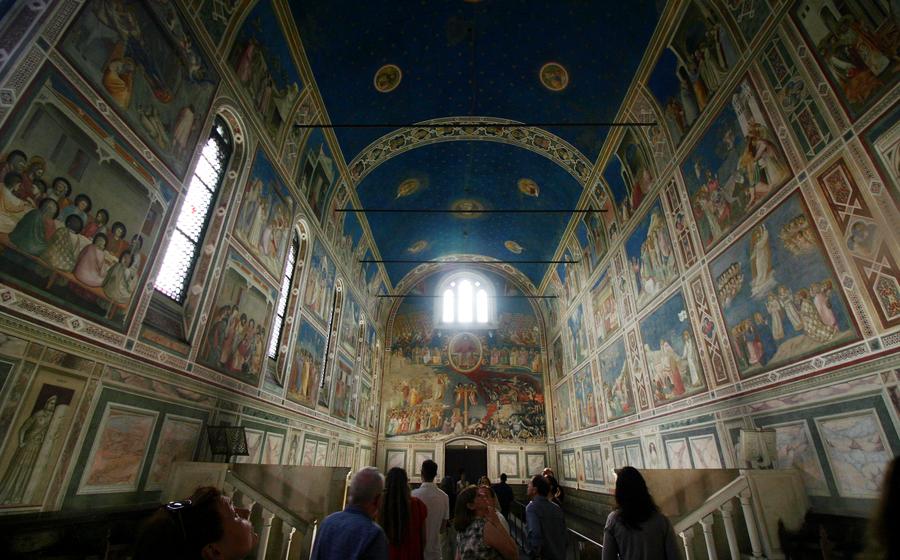
Scrovegni Chapel
- Introduction - The Allure of Padua and the Scrovegni Chapel
- Stepping Inside - A Celestial Realm
- The Importance of the Arena Chapel
- Exploring the Life of Giotto
- The Scrovegni Family's Legacy
- Padua - A City of Art and Culture
- Practical Information for Visitors
- Understanding the Chapel's Symbolism
- Preservation and Restoration Efforts
- The Influence of Giotto on Modern Art
- Unique Photo Opportunities
- Insider Tip - Enhancing Your Visit
Introduction - The Allure of Padua and the Scrovegni Chapel
Nestled in the heart of the Veneto region, Padua, a city steeped in history and culture, beckons travelers with its captivating charm. Among its many treasures, the Scrovegni Chapel stands as a testament to the genius of Giotto, a revolutionary artist who transformed the course of art history. A visit to this extraordinary chapel is a pilgrimage to the birthplace of the Renaissance, where Giotto's masterful frescoes unveil a world of divine beauty and profound spiritual contemplation.
The Scrovegni Chapel is not just a work of art; it is a sanctuary that invites visitors to transcend the boundaries of time and space, immersing them in a celestial realm where faith, art, and history converge. Prepare to be spellbound as you step into this sacred space, where Giotto's frescoes narrate the life of Christ with unparalleled artistry, igniting a symphony of emotions that will resonate long after your visit.
Practical Information:
- Location: Piazza Eremitani, 8, 35121 Padova PD, Italy
- Opening Hours: Tuesday to Sunday, 9 am to 7 pm; closed on Mondays
- Admission Fees: Full price: €15; reduced price (students, seniors): €12
- Booking: Advance booking is recommended, especially during peak season. Tickets can be purchased online or at the ticket office on-site.
Stepping Inside - A Celestial Realm
The interior of the Scrovegni Chapel is simply breathtaking. As you step through the doors, you'll be greeted by a symphony of colors, light, and emotion that will transport you to another realm. Giotto's frescoes cover every inch of the walls and ceiling, creating a celestial atmosphere that inspires awe and wonder.
The use of light is particularly striking. Giotto cleverly manipulated the natural light entering the chapel to create a sense of depth and perspective. The frescoes seem to come alive as the light dances across them, casting shadows and highlighting details that would otherwise go unnoticed.
The colors are equally impressive. Giotto's palette is rich and vibrant, with deep blues, reds, and golds that create a sense of warmth and opulence. The blues of the sky are particularly striking, and they seem to extend beyond the walls of the chapel, creating the illusion of an infinite celestial expanse.
The overall emotional impact of the chapel's interior is one of profound peace and tranquility. Giotto's frescoes invite you to contemplate the life of Christ and the mysteries of faith. The serene expressions on the faces of the figures and the harmonious composition of the scenes create a sense of calm and serenity that is truly unique.
To maximize your experience inside the chapel, take your time to explore every nook and cranny. Study the details of the frescoes and let your eyes wander from one scene to the next. Allow yourself to be immersed in the beauty and spirituality of this extraordinary space.
The Importance of the Arena Chapel
The Scrovegni Chapel, often referred to as the Arena Chapel, holds immense historical significance as one of the earliest examples of a fresco cycle in Western art. Created during the late 13th and early 14th centuries, it represents a pivotal moment in the development of painting. Giotto's innovative approach to naturalism and perspective in his frescoes paved the way for a new era in art.
Giotto's work in the Arena Chapel had a profound impact on the trajectory of Western art. His revolutionary techniques and narrative style influenced generations of artists, including some of the most renowned masters of the Renaissance such as Michelangelo and Raphael. The chapel's frescoes became a model for subsequent fresco cycles, inspiring artists to explore the potential of this medium to convey complex narratives and emotions.
The Scrovegni Chapel's enduring legacy extends beyond its artistic influence. In 2000, it was designated a UNESCO World Heritage Site in recognition of its outstanding universal value. This prestigious designation highlights the chapel's significance as a cultural landmark and its contribution to the world's artistic heritage. The chapel continues to captivate visitors with its breathtaking beauty and serves as a testament to the genius of Giotto and the transformative power of art.
Exploring the Life of Giotto
The story of Giotto, the revolutionary artist behind the Scrovegni Chapel's frescoes, is a tale of humble beginnings and extraordinary talent. Born in the small town of Colle di Vespignano near Florence around 1266, Giotto's artistic journey began as a shepherd boy. Legend has it that the renowned painter Cimabue discovered Giotto sketching on a rock while tending his sheep. Recognizing the raw talent in the young boy, Cimabue took him under his wing and became his mentor.
Giotto's natural ability and passion for art propelled him to become one of the most influential figures in the history of Western art. Breaking away from the stylized conventions of Byzantine art, Giotto introduced a new era of naturalism and realism to painting. His figures depicted in the Scrovegni Chapel possess a remarkable sense of depth, emotion, and individuality, reflecting a profound understanding of human anatomy and perspective.
Giotto's revolutionary approach extended beyond his technical skills. He was among the first artists to use perspective to create the illusion of three-dimensionality in his paintings. This groundbreaking technique allowed him to depict scenes with depth and realism that were previously unseen in medieval art.
Giotto's influence on the development of the Renaissance can hardly be overstated. His innovations paved the way for a new era of artistic expression, inspiring subsequent generations of artists, including Michelangelo, Raphael, and Leonardo da Vinci. Giotto's legacy lives on, not only in the awe-inspiring frescoes of the Scrovegni Chapel but also in the countless works of art that followed in his footsteps.
The Scrovegni Family's Legacy
The Scrovegni family, responsible for commissioning the Scrovegni Chapel, played a pivotal role in shaping the cultural and economic landscape of Padua during the 14th century. Enrico Scrovegni, a wealthy merchant and banker, sought to create a lasting legacy for his family through the construction of this stunning masterpiece. Motivated by both religious devotion and a desire for social prestige, the Scrovegni family spared no expense in commissioning Giotto, the most renowned artist of the time, to decorate the chapel.
The chapel's sumptuous interior, adorned with Giotto's exquisite frescoes, not only served as a tribute to the family's faith but also reflected their prosperity and influence. Enrico Scrovegni's shrewd business acumen had amassed a vast fortune, allowing him to invest heavily in the construction and decoration of the chapel. His decision to commission Giotto demonstrated his family's refined taste and their commitment to artistic patronage.
Beyond their involvement in the chapel, the Scrovegni family played a significant role in Padua's civic and political life. They held prominent positions in the city's government, contributing to its development and prosperity. Their wealth and influence extended beyond Padua, as they established business connections throughout Europe.
The Scrovegni family's legacy is inextricably linked to the Scrovegni Chapel, a testament to their enduring impact on Padua's cultural heritage. Their patronage of Giotto's masterpiece not only enriched the city's artistic landscape but also cemented their family's place in history as influential figures of the Renaissance era.
Padua - A City of Art and Culture
Padua, the city that hosts the magnificent Scrovegni Chapel, boasts a rich history and cultural heritage that extends far beyond this iconic landmark. With its ancient origins dating back to the Roman era, Padua has been a center of learning and culture for centuries. The city is home to the prestigious University of Padua, founded in 1222, which has attracted scholars and intellectuals from around the world.
Strolling through Padua's charming streets, visitors can admire architectural masterpieces from different eras, including the Palazzo della Ragione, a stunning example of medieval architecture, and the Basilica of Saint Anthony, a sacred site that attracts pilgrims from all over the world. The city also houses several museums, including the Civic Museums of Padua, which showcase a vast collection of art and artifacts, and the Museum of Precinema, dedicated to the history of early cinema and optical illusions.
Beyond its historical and cultural attractions, Padua offers a vibrant and youthful atmosphere thanks to its large student population. The city is home to numerous cafes, bars, and restaurants, where students and locals alike gather to socialize and enjoy the lively atmosphere. Visitors can immerse themselves in the city's vibrant student life by attending cultural events, concerts, and festivals held throughout the year.
Exploring Padua beyond the Scrovegni Chapel offers a rewarding experience, allowing visitors to discover the city's hidden gems and diverse cultural offerings. Whether you're interested in history, art, architecture, or simply soaking up the local atmosphere, Padua has something to offer every traveler.
Practical Information for Visitors
Before embarking on your journey to the Scrovegni Chapel, it's important to equip yourself with essential practical information. Firstly, the chapel's opening hours vary depending on the season, so checking the official website or contacting the local tourist office is advisable. Admission fees are typically charged, with reduced rates for students and seniors. Advance booking is highly recommended to avoid disappointment, especially during peak tourist seasons.
Guided tours are available in multiple languages, providing an immersive and informative experience. These tours offer expert insights into the chapel's history, symbolism, and artistic significance. Audio guides are also available for self-guided exploration at your own pace.
For disabled visitors, the chapel is wheelchair accessible, and staff is on hand to assist with any special requirements. Additionally, visitors can find a selection of nearby restaurants and cafes to enjoy a delightful meal or a refreshing beverage before or after their visit to the chapel.
Understanding the Chapel's Symbolism
Giotto's frescoes in the Scrovegni Chapel are not merely decorative; they carry profound meanings that invite viewers to contemplate the deeper dimensions of the Christian faith. Every detail, from the vibrant colors to the intricate compositions, holds symbolic significance.
The chapel's interior is dominated by the radiant blue ceiling, representing the celestial realm. The stars symbolize the divine order and the presence of God. The walls are adorned with narrative scenes depicting the life of Christ, each conveying theological messages and moral lessons.
Giotto's use of color is particularly noteworthy. The blues and golds evoke a sense of heavenly splendor, while the earthy tones in the lower registers ground the narrative in reality. The artist's innovative use of perspective creates a sense of depth, drawing viewers into the sacred space.
The chapel's iconography also reflects the medieval worldview, where every element of creation held symbolic meaning. Animals, plants, and objects are carefully placed to convey spiritual truths. For instance, the peacock represents immortality, the lamb symbolizes purity, and the dove signifies the Holy Spirit.
Understanding the chapel's symbolism enriches the visitor's experience, inviting them to decode the hidden messages embedded within the artwork. Guided tours and informative resources are available to help visitors delve deeper into the chapel's rich symbolism, revealing the profound theological and spiritual messages that lie beneath the surface.
Preservation and Restoration Efforts
The Scrovegni Chapel has undergone several restoration projects throughout history to preserve its delicate frescoes. In the 19th century, a major restoration campaign removed centuries of dirt and grime, revealing the vibrant colors and intricate details of Giotto's work. In the 1960s, another restoration project focused on structural repairs and the stabilization of the chapel's foundations.
One of the most recent restoration projects, completed in 2002, involved the cleaning and conservation of the frescoes using state-of-the-art techniques. This project aimed to remove centuries of accumulated dust and pollution while preserving the original pigments and brushstrokes.
The restoration process presented several challenges, including the removal of old varnishes and adhesives without damaging the delicate paint layers. Conservators also had to address structural issues such as cracks and moisture damage.
Thanks to the dedication and expertise of conservators, the Scrovegni Chapel's frescoes have been preserved for future generations to enjoy. Ongoing monitoring and maintenance ensure that this masterpiece of the Italian Renaissance continues to inspire and awe visitors from around the world.
The Influence of Giotto on Modern Art
Giotto's revolutionary impact on art extended far beyond his own time. His mastery of perspective and realism laid the foundation for the development of modern art. Subsequent generations of artists, including Michelangelo, Raphael, and Leonardo da Vinci, drew inspiration from Giotto's groundbreaking techniques.
Giotto's influence can be seen in the works of many modern artists, who continue to find inspiration in his innovative approach to painting. For instance, the surrealist painter Salvador Dalí was captivated by Giotto's use of perspective and incorporated it into his own works, such as "The Persistence of Memory." Contemporary artists like David Hockney and Gerhard Richter have also paid homage to Giotto, referencing his style and iconography in their own artistic practices.
The legacy of the Scrovegni Chapel continues to resonate in contemporary art, serving as a reminder of Giotto's enduring influence. His ability to capture the human experience with such depth and emotion remains a source of inspiration for artists worldwide.
Unique Photo Opportunities
The Scrovegni Chapel is a photographer's paradise, offering countless opportunities to capture its breathtaking beauty. To make the most of your visit, consider the following tips:
-
Play with Light: The chapel's interior is illuminated by natural light that filters through the windows, creating dramatic lighting effects. Experiment with different angles and times of day to capture the chapel's unique atmosphere.
-
Compose Your Shots: Giotto's frescoes are arranged in a narrative sequence. Take advantage of this by capturing wide-angle shots that showcase the progression of the story. Look for interesting compositions that highlight the frescoes' details and relationships.
-
Embrace the Reflections: The chapel's interior is adorned with reflective surfaces, such as the golden mosaics and polished marble. Use these elements to create intriguing reflections that add depth and dimension to your photographs.
-
Go Beyond the Obvious: While the frescoes are the main attraction, don't overlook the chapel's exterior and surrounding area. Capture the interplay of light and shadow on the chapel's facade, or explore the nearby streets and piazzas for unique perspectives.
-
Share Your Vision: Don't forget to share your stunning captures with the world. Use social media platforms and online photography communities to showcase your work and inspire fellow travelers.
Insider Tip - Enhancing Your Visit
To ensure a truly enriching experience at the Scrovegni Chapel, consider adopting these insider tips:
-
Advance Booking: To avoid the hassles of long queues and disappointment, book your tickets online well in advance. This guarantees your entry and allows you to seamlessly plan your visit.
-
Guided Tours: Enhance your understanding of the chapel's history, iconography, and significance by joining a guided tour. Expert guides provide insightful commentary, unveiling the hidden meanings and stories behind Giotto's masterpieces.
-
Off-Peak Hours: For a more serene and intimate experience, visit the chapel during off-peak hours, typically early mornings or late afternoons. The reduced crowds offer the tranquility needed to fully appreciate the chapel's beauty and spiritual atmosphere.
-
Explore the Surroundings: After your visit to the chapel, take the opportunity to explore the captivating surroundings of Padua. Discover hidden gems like the Palazzo della Ragione, the Prato della Valle, and the Botanical Garden, each offering unique cultural and historical experiences.
